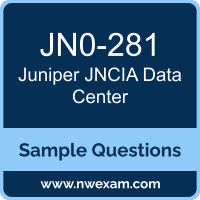01. What are two common reasons for BGP routes to be in the hidden state?
(Choose two.)
a) Routes are being rejected by a policy
b) Routes are being filtered from the inet.2 routing table
c) The next hop is unresolvable
d) The BGP neighbor is in a different autonomous system
02. You have configured a load balancing policy. Which statement is correct about applying the policy?
a) The policy is applied as an export policy under the routing protocol’s hierarchy.
b) The policy is applied as an export policy under routing-options forwarding table.
c) The policy is applied as an import policy under the routing protocol’s hierarchy.
d) The policy is applied as an import policy under routing-options forwarding table.
03. Under which Junos hierarchy is a static route configured?
a) system
b) routing-instances
c) routing-options
d) protocols
04. How does a layer 2 switch populate its bridge table?
a) It stores the protocol number of frames traversing the network.
b) It stores both the source and destination MAC addresses of frames traversing the network.
c) It stores the destination MAC address of frames traversing the network.
d) It stores the source MAC address of frames traversing the network.
05. In the Junos OS, what is the default behavior of a switch when it receives a frame with an unknown destination MAC address?
a) It discards the frame.
b) It floods the frame out of all ports except the one it was received on.
c) It sends the frame to its default gateway.
d) It buffers the frame until the MAC address can be learned.
06. Which two protocols can you use for a data center underlay network?
(Choose two)
a) EBGP
b) OSPF
c) VXLAN
d) EVPN
07. In the context of data center networking, what is the primary purpose of an Underlay Network?
a) To provide a physical infrastructure for an Overlay Network.
b) To handle external network connections exclusively.
c) To facilitate virtual machine migrations.
d) To encrypt data traffic between servers.
08. With regards to graceful restart, which two statements are true?
(Choose two.)
a) A supported routing protocol, such as BGP, must be operational for graceful restart to work.
b) NSR must be enabled for graceful restart to work.
c) Dual routing engines are required for graceful restart to work.
d) The network topology must be stable for graceful restart to work.
09. EVPN/VXLAN is primarily used in modern data centers to:
a) Increase the physical distance between data centers.
b) Provide Layer 2 connectivity over a Layer 3 network.
c) Replace traditional routing protocols.
d) Enhance the physical security of the data center.
10. Which two statements are correct about aggregated Ethernet bundles?
(Choose two.)
a) You must enable the chassis to support aggregated Ethernet interfaces.
b) You must purchase a services license for the chassis to support aggregate Ethernet interfaces.
c) You must specify which interfaces are members of a specific aggregated Ethernet bundle.
d) You must enable LACP when configuring aggregated Ethernet bundles.
 Before you write the Juniper JNCIA Data Center (JN0-281) certification exam, you may have certain doubts in your mind regarding the pattern of the test, the types of questions asked in it, the difficulty level of the questions and time required to complete the questions. These Juniper Networks Certified Associate Data Center (JNCIA-DC) sample questions and demo exam help you in removing these doubts and prepare you to take the test.
Before you write the Juniper JNCIA Data Center (JN0-281) certification exam, you may have certain doubts in your mind regarding the pattern of the test, the types of questions asked in it, the difficulty level of the questions and time required to complete the questions. These Juniper Networks Certified Associate Data Center (JNCIA-DC) sample questions and demo exam help you in removing these doubts and prepare you to take the test.